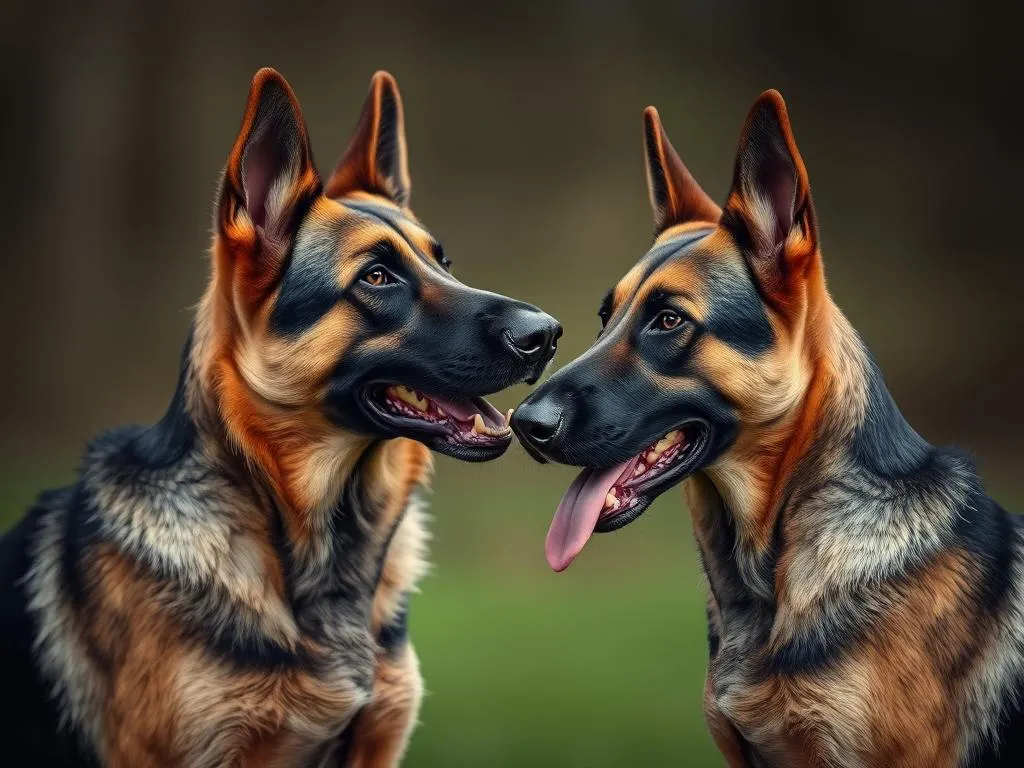
Understanding the difference between Dutch Shepherds and Belgian Malinois can significantly influence potential dog owners’ decisions. Both breeds are renowned for their intelligence, loyalty, and versatility, making them popular choices among dog enthusiasts. However, they possess distinct characteristics that set them apart. This article provides a comprehensive comparison of these two remarkable breeds.
Breed Overview
Dutch Shepherd
The Dutch Shepherd originated in the Netherlands, primarily developed for herding sheep and cattle. Their history is intertwined with the need for a reliable working dog, which has shaped their capabilities today.
In terms of physical characteristics, Dutch Shepherds are medium-sized dogs, typically standing between 21 to 24 inches tall and weighing between 50 to 75 pounds. They have a unique coat that comes in three types: short-haired, long-haired, and rough-haired, often showcasing a brindle pattern in shades of gold and silver.
The temperament of a Dutch Shepherd is generally friendly and loyal, making them excellent family pets. They are intelligent and eager to please, which aids in training. However, they require a consistent training approach due to their strong-willed nature. Common health issues include hip dysplasia and eye problems, with a lifespan of approximately 12 to 15 years.
Belgian Malinois
The Belgian Malinois has its roots in Belgium, where it was originally bred for herding and protection. Over the years, this breed has gained popularity in various working roles, including police and military work.
Physical characteristics of the Belgian Malinois include a height range of 22 to 26 inches and a weight of about 40 to 80 pounds. They possess a short, fawn-colored coat with a black mask, which adds to their striking appearance.
When it comes to temperament, Belgian Malinois dogs are known for their high energy and intelligence. They are incredibly loyal and form strong bonds with their families. However, they require ample physical and mental stimulation, making them better suited for active households. Common health concerns for Belgian Malinois include hip dysplasia and certain skin conditions, and they typically live between 12 to 14 years.
Comparison of Physical Attributes
Size and Weight
Both breeds are similar in size, though the Belgian Malinois generally falls on the taller side. The average height for a Dutch Shepherd is between 21 to 24 inches, while the Belgian Malinois stands at 22 to 26 inches. Weight-wise, both breeds can vary significantly based on genetics and diet, but Dutch Shepherds tend to be slightly heavier, averaging 50 to 75 pounds, in contrast to the Belgian Malinois, which averages between 40 to 80 pounds.
Coat and Grooming
The grooming requirements for both breeds differ due to their coat types. Dutch Shepherds can have short, long, or rough coats, which typically require regular brushing to manage shedding, especially during seasonal changes.
On the other hand, the Belgian Malinois has a dense, short coat that also sheds but requires less grooming compared to the Dutch Shepherd. Regular brushing is recommended to keep their coat healthy and minimize shedding.
Color Variations
Dutch Shepherds are primarily recognized for their brindle coloration, which can come in various shades of gold and silver. They may also have a mix of black markings.
Conversely, the Belgian Malinois is predominantly fawn, with a black mask. Their coat can vary slightly in shade but generally remains within the fawn to mahogany spectrum.
Temperament and Behavior
Energy Levels
Both breeds are highly energetic and require significant exercise, but their needs can differ slightly. Dutch Shepherds enjoy a mix of physical and mental activities, thriving in environments where they can engage in tasks that challenge their intelligence.
Belgian Malinois dogs also require rigorous exercise and tend to excel in environments that offer agility training and obedience exercises. Their high energy levels make them suitable for active individuals or families who can dedicate time to their daily needs.
Trainability
In terms of trainability, both breeds rank high due to their intelligence and eagerness to learn. Dutch Shepherds respond well to positive reinforcement and consistent training. They can sometimes exhibit stubbornness, so patience is key.
Belgian Malinois dogs are known for their quick learning capabilities, making them ideal candidates for advanced training and specialized roles. They thrive on challenges, and their willingness to work closely with humans makes them one of the best breeds for service and protection.
Socialization
Both breeds require early socialization to develop into well-rounded adult dogs. Dutch Shepherds typically get along well with children and other pets, but proper introduction and supervision are essential.
Belgian Malinois also do well with children, though they may exhibit a more protective nature. They require early exposure to various environments and social situations to help manage their instinctual guarding tendencies.
Working Roles and Capabilities
Roles in Law Enforcement and Military
Historically, both breeds have been utilized in law enforcement and military roles. The Dutch Shepherd has gained recognition for its versatility and adaptability, often serving in K9 units for search and rescue, narcotics detection, and protection.
The Belgian Malinois is perhaps best known for its role as a police and military dog, excelling in tasks that require agility, speed, and intelligence. Their superior scent-tracking abilities and focus make them highly effective in various operational roles.
Sports and Competitions
In the realm of sports and competitions, both breeds shine. Dutch Shepherds often participate in agility, obedience, and herding trials, showcasing their versatility and athleticism.
Belgian Malinois dogs frequently dominate in competitive settings such as agility, protection sports, and obedience trials, earning numerous accolades and recognition. Their drive and determination make them formidable competitors in the canine sports arena.
Health and Lifespan
Common Health Problems
When comparing health issues, both breeds share some common concerns. Dutch Shepherds are prone to hip dysplasia, eye problems, and certain skin conditions. Regular veterinary check-ups and genetic testing can help mitigate some of these risks.
Belgian Malinois also face similar health challenges, particularly hip dysplasia and skin allergies. Responsible breeding practices can help reduce the prevalence of these conditions within the breed.
Lifespan Expectations
The average lifespan for both breeds is relatively similar, with Dutch Shepherds living between 12 to 15 years and Belgian Malinois between 12 to 14 years. Factors influencing longevity include genetics, diet, exercise, and overall health care.
Ideal Owner Profile
Lifestyle Considerations
Both breeds thrive in active households. Dutch Shepherds are well-suited for families who can provide ample exercise and mental stimulation, whether through outdoor activities or engaging in dog sports.
Belgian Malinois require even more activity and may be better suited for individuals or families who lead a highly active lifestyle, including running, hiking, or participating in dog sports regularly.
Experience Level
For potential owners, the Dutch Shepherd may be better suited for those with some experience in dog training, while the Belgian Malinois is often recommended for experienced handlers due to their high energy and intelligence. First-time dog owners may find Dutch Shepherds slightly more manageable, though both breeds require dedication and commitment.
Cost and Availability
Initial Purchase Price
The initial purchase price can vary significantly between the two breeds. On average, a Dutch Shepherd may cost between $1,000 to $3,000, depending on the breeder’s reputation and lineage.
Belgian Malinois puppies can range from $1,500 to $3,000, especially if they come from working lines. Factors affecting these prices include breeder reputation, location, and demand for the breed.
Ongoing Expenses
Ongoing expenses for both breeds are similar, including costs for high-quality food, grooming, and veterinary care. Owners should budget for regular health check-ups and vaccinations.
Training classes, especially for Belgian Malinois, can be an important investment given their need for advanced training and socialization. Participation in dog sports may also incur additional costs, including equipment and travel fees.
Conclusion
In conclusion, both Dutch Shepherds and Belgian Malinois are intelligent, loyal, and versatile breeds that excel in various roles, from family pets to working dogs. While they share similarities, their distinct characteristics can significantly influence the best fit for potential owners.
A Dutch Shepherd may be ideal for those looking for a loyal companion with a friendly temperament, while a Belgian Malinois may suit individuals seeking a highly energetic dog with exceptional working capabilities. Researching both breeds further and considering personal lifestyle and experience level will help prospective owners make informed decisions.
FAQs
What are the main differences between Dutch Shepherds and Belgian Malinois?
While both breeds are intelligent and energetic, Dutch Shepherds tend to be more versatile in family settings, whereas Belgian Malinois excel in working roles like police and military tasks.
Are Dutch Shepherds good family pets?
Yes, Dutch Shepherds are known for their friendly demeanor and can be excellent family pets, especially with proper training and socialization.
How much exercise do Belgian Malinois need?
Belgian Malinois require a significant amount of exercise—at least 1-2 hours daily—along with mental stimulation to prevent boredom.
What health issues are common in Dutch Shepherds?
Dutch Shepherds may face health issues such as hip dysplasia, eye problems, and skin conditions.
Is a Belgian Malinois suitable for first-time dog owners?
Due to their high energy and training needs, Belgian Malinois are generally better suited for experienced dog owners rather than first-time handlers.
By understanding the nuances between Dutch Shepherds and Belgian Malinois, potential dog owners can make informed decisions that align with their lifestyles and preferences.









